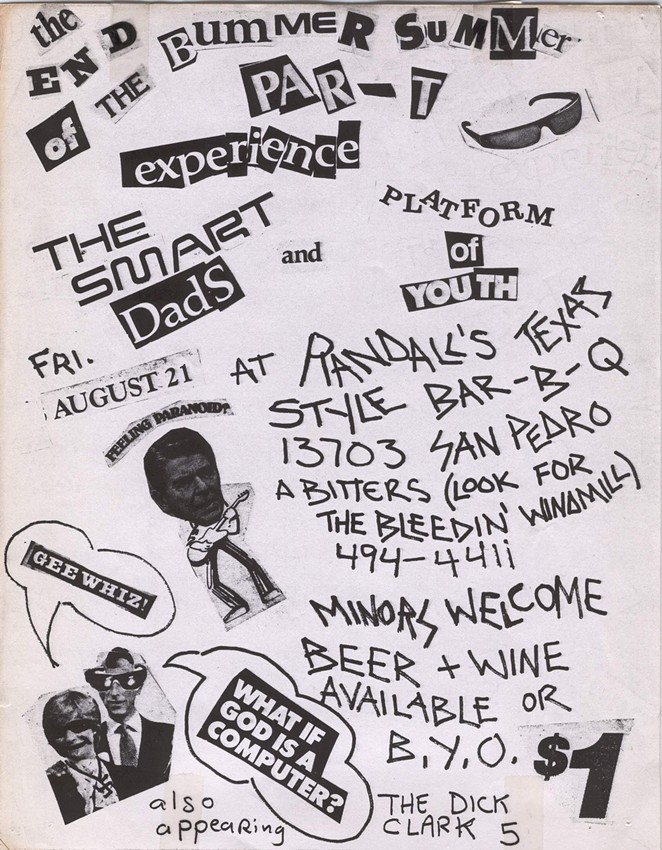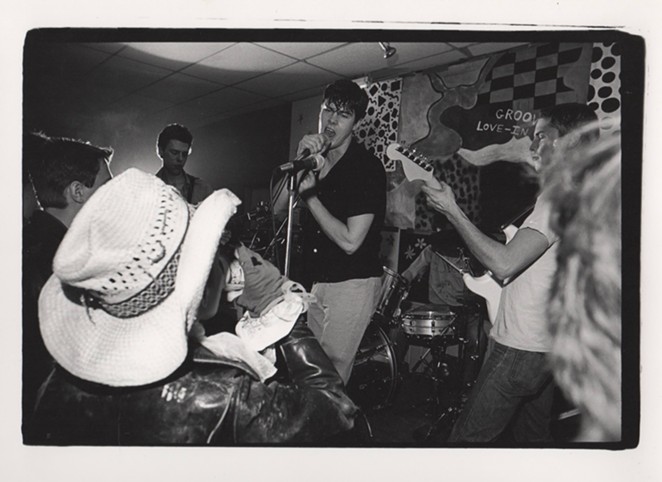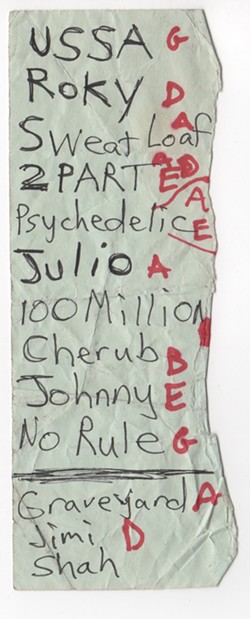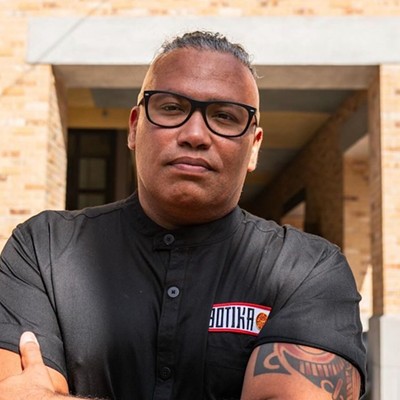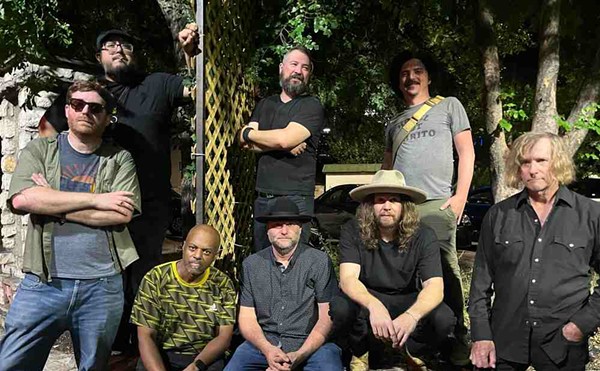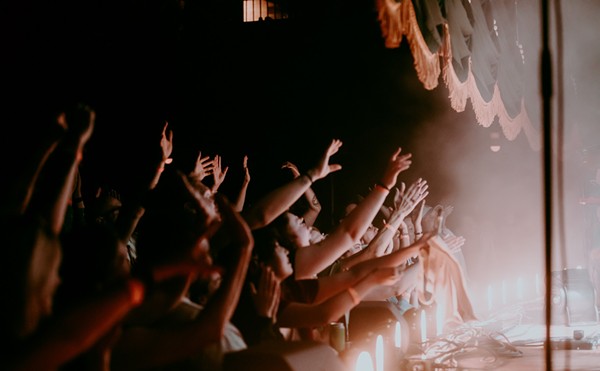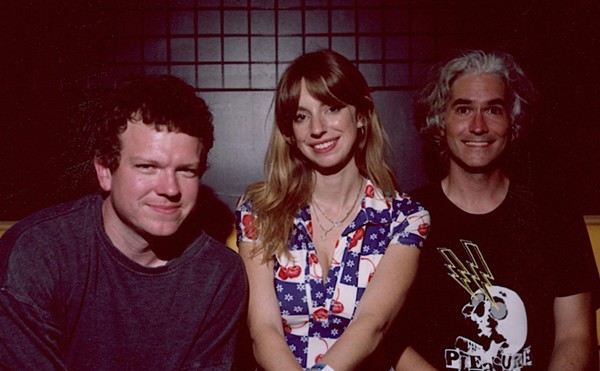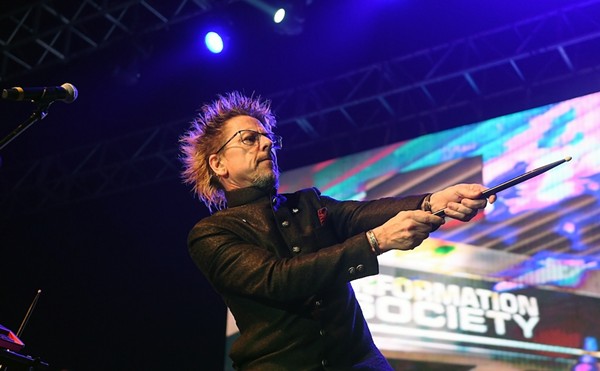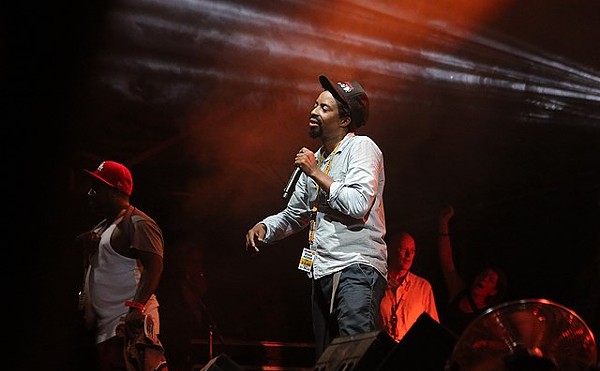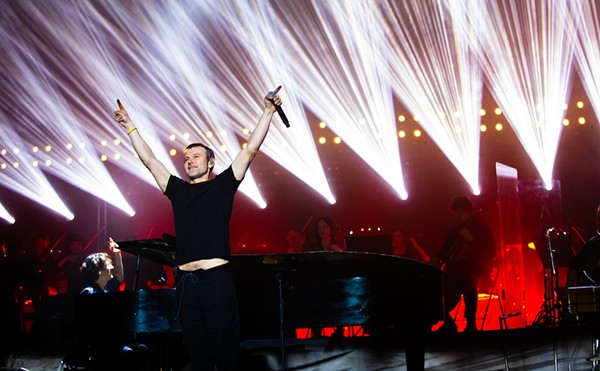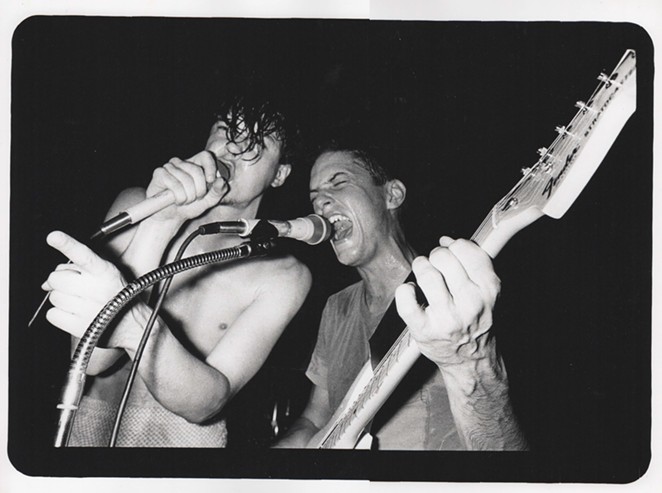
Born in an isolated late-’70s San Antonio punk rock scene, the Butthole Surfers eventually grew into one of the premier underground acts of the ’80s and ’90s. The band’s potent fusion of post-punk, performance art, Texas psych and theater of the absurd cemented it as one of the era’s most enigmatic and compelling musical ensembles.
“We became what we wanted to see in a rock band,” guitarist Paul Leary said of the band in 2018. “It helped that there was no message we were trying to convey. It was all kinda nihilistic.”Much of that nihilism stemmed from the members’ feeling that culture at large had stagnated — a realization formed in part during their Alamo City years. After the youth explosion of the ’60s, many Baby Boomers put away their tie-dyed tapestries, donned pinstripe suits and lined up in cookie-cutter uniformity.
The Buttholes sought to undermine, ridicule and subvert that bland culture — and they succeeded beyond their wildest dreams.
Their music combined Leary’s fevered guitar scrabbling — equal parts mild-melting psychedelia and post-punk noise — with frontman Gibby Haynes’ unhinged vocals, often crackling through a bullhorn or buried under a sludgy mudslide of delay. The band’s dual drummers thudded behind them with tribal fury.
In the pre-internet, word-of-mouth underground, the band became the reigning kings of a growing weird-rock scene. Their unhinged live shows spread fear and awe through crowds worldwide.
The impact of the group was seismic, galvanizing and lasting. Nirvana’s Kurt Cobain listed the Surfers’ first EP as one of the 10 greatest records ever made, and New York avant-jazz legend John Zorn also sang their praises. By the ’90s, the absurdity reached new heights as the band topped the alternative charts with “Pepper,” recorded the MTV theme song and had its songs appear in Hollywood movie soundtracks.
As further evidence of the ’holes lasting influence, a feature-length documentary on the band announced in December from director Tom Stern blew past the $50,000 goal of its online fundraising campaign in less than a week.
For many fans, however, the Surfers’ most compelling work emerged from their time in San Antonio, from 1978 to 1984. The city was smaller then, isolated from cultural trends. But rather than stifling the members’ creative drive, that parochialism lit a spark and helped shape its musical voice.
We caught up with Leary and drummer King Coffey, along with others who passed through the band or were drawn into its orbit during those formative San Antonio years. Haynes and drummer Teresa Taylor didn’t respond to interview requests.
What follows is an oral history of the rowdy misfits’ formative years in the Alamo City.
‘Showman right from the start’
Paul Leary: I grew up in North Central San Antonio, near San Pedro and Hildebrand [avenues]. It was pretty fun. San Antonio was like a giant small town with a cool Hispanic vibe. I started playing guitar at age 5. I wanted to be Chet Atkins.
Scott Stevens (former bassist): Gibby’s dad was a children’s TV show host in Dallas: Mr. Peppermint. He’d go on the show. Gibby was a showman right from the start.
Jerry Haynes (Gibby’s dad): In the mid-’60s, Gibby would come down and help a little bit on the show. Once, his chair fell over backwards. He fell over five or six feet, and he came up laughing. He could do anything. He learned how to blow five bubbles within bubbles, then moved on from that. (Spin, 1996)
Scott Stevens: Gibby had seen that being in show business was not financially stable. That’s why he went for the accountant degree. He was the star accounting student in a black leather jacket. I met him in ’78. Trinity [University] was a pretty conservative school at that time — lots of Biffs and Muffies. That was my feeling anyway. Everything seemed very uptight and conservative.
A stifling Texas culture
King Coffey: Isolation. I think that’s the nature of Texas Punk. We were so far removed from the coasts. And Texas is so spread out. This was before there was any kind of touring network, any kind of punk network to tap into. So, we were left to our own devices. In Texas, you could look back to the ’60s, bands like the 13th Floor Elevators, who were a lot more “out there” than their contemporaries, and I think that had a lot to do with the isolation Texas had at the time. Pre-internet, obviously. It was hard to get to know other bands outside your city.
Paul Leary: We were definitely a product of our time, and a product of Texas. Music out of Texas has always been different than other places. I think only Texas could have produced the Butthole Surfers. We were just plain weird. We were reacting to everything around us and lashing out.
Chris Smart (early acquaintance): What was happening was all just so ... boring. So, we were anti-everything. Anti-’70s, anti-hippie. As a result, everyone hated our little crowd of people. It was great actually, because it drove everybody to do more. “You hate that? Well, you’re gonna hate our new band! You’re gonna hate our new songs! It’s gonna piss you off, and that’s what we’re here to do, because you’re all so insanely boring.” So, it worked to our benefit, in a way. Because the only way movements happen is through isolation and animosity. There have to be people against you, something you’re fighting against.
Discovering a musical underground
Chris Smart: It’s hard to imagine now what San Antonio was like back then. There was no college radio, no underground papers, no clubs to play, and we got threatened all the time by police, jocks, heavy metal guys, straight guys. I used to get called “faggot” every day. My band, the guys in the Surfers. All of us. Every day, somebody would drive by yelling, “Hey, you punk rock faggots!” Every damn day.
King Coffey: The Buttholes took a lot from the Dicks and the Big Boys, who were themselves oddball Texans. For punk rockers, they were strange. They kind of laid the template for a lot of the performance aspects of what the Buttholes did. But Gibby and Paul were bringing their own weird take on it. Paul was actually a great musician, so that was unique. And they were both art students, so there was really no dogma that they had to pursue or obey. No punk rock dogma. Punk rock was painting itself into a corner. ... We considered ourselves punks, but we’d gotten quite bored with the “‘rules” of punk music.
Chris Smart: There were only about 30 people in that whole SA scene, and we were all connected. Like the Pugliese brothers. The Vamps’ keyboard player was Joe Pugliese, who brought all the important bands to town. He doesn’t get any credit. These were important shows! Brought the Sex Pistols, the Ramones, Iggy Pop, Patti Smith, John Cale. All these shows that were just ... too soon.
Bill Daniel (band collaborator and photographer): There was so much time and space in San Antonio back then that artists could completely live devoted to their work. Isolation and time mean you can come up with something completely unique. Plus, you’ve got enough of a scene you can plug into, which is open-minded enough that you can come in and do your thing that’s totally different. The underground audience wasn’t huge, but it was really open-minded, really supportive.
Trinity’s freaks unite
Paul Leary: I met Gibby at Trinity University, and he talked me into playing guitar again. Which I did with a whole different attitude. By then, I was listening to Meat Puppets and Black Flag, and that was inspirational.
Scott Stevens: I went to Trinity with Paul and Gibby. I was in a drawing class with Paul, and he was a really good artist. We didn’t talk much. In fall of ’78, in printmaking class, the teacher was a real jerk. Everything had to be “drawn from nature.” Paul did a drawing of a T-rex with big teeth, a dog with big teeth and a lawnmower with big teeth, and they were all going around in a circle. He called it “Dada Dog Damage.” The teacher took great exception to it: “I told you to draw something from life.” And Paul said, “Well, I have a little toy T-rex on my breakfast table I see every morning.”
Terence Smart (former bassist): Paul and I are faculty children. His dad taught in the Trinity business department, and my father taught in the history department. So, I knew of him. ... I knew Gibby from 1977 and ’78 in the dorms. We were friends and did a show together in the theater department. Trinity had a great theater and arts department — an amazing place to be. In ’81 or ’82, they got a new president and things changed. But for a while, it was pure creativity. And Gibby was an amazing artist from the word go. A great basketball player too. Captain of the team.
Scott Stevens: I’d heard of Gibby Haynes in the fall of ’78. He was a tall skinny guy — an accounting student in a black leather jacket. He was also the president of the Theta fraternity. And they were the hardcore party fraternity house. Not just suds, if you know what I mean. He was the last person in that frat. The university shut it down, trying to clean up the school’s image.
Jerry Haynes: [Gibby] did a lot of weird things at Trinity. He played nude tennis and got arrested by the campus police. He entered an art contest. The name of the piece was Hold the Pickles at Auschwitz. He was brought before the student government. They said it was anti-Semitic. He was never subtle, I guess. But he’s pretty smart. He got the Accountant of the Year award down at Trinity. (Spin, 1996).
Scott Stevens: With Paul and Gibby, there was a small crew of us. We did vandal art. Doing weird images and putting them around the campus. We wrapped a mannequin and put it in front of the dorms. We covered the whole side of a dorm with Sound Warehouse stickers.
Quinn Matthews (former bassist): Paul spent most of his student loan on getting a bass, guitars and amps for everybody. My brother Scott was the original drummer.
The theatrics begin
Scott Stevens: The first time the Butthole Surfers played was at a San Antonio art gallery, the Davenport Gallery. The owners loved it but couldn’t hear the lyrics. We had a PA for the second show, and when they heard the lyrics for the first time to “I Fuck Your Wife” and “Butthole Surfer,” well, they didn’t like it much. That was that. But Gibby was a showman. He had a pet roach and made a photocopy of it. It was like a ticker tape parade, but all the [confetti had] images of cockroaches. ... We were playing as the Dick Clark Five. The idea being we’d get sued by Dick Clark and get publicity. That was Paul’s idea.
Jeff Smith (early acquaintance and current Hickoid): Gibby comes up and starts haranguing me. “Hey, I heard you’re booking shows at some place called Texas Style Barbecue.” He and Paul are living in a shack around the corner. He makes me come over and listen to their demo tape. It’s the most godawful thing I’ve ever heard in my life. I was like, “Sure, you can play this show we got coming up.” (Laughs.) A show with the Mystery Dates, my band — the Smart Dads — and Platform of Youth.
Chris Smart: My first band was Platform of Youth, and one of our first shows was one of the Surfers’ first shows. They were called the Dick Gas Five. Jeff Smith set up the show at a barbecue place, out [U.S. Highway] 281 and Bitters [Road], back when there was nothing out there. The owner of the barbecue restaurant wouldn’t let them put Dick Gas Five on the sign out front, so they changed it to the Dick Clark Five. The Surfers had played two art galleries and then in Austin. So, this was their first San Antonio show, really.
Jeff Smith: Gibby was doing the earthworm, laying on the ground, shaking. They were outrageous. The music was still not realized, but they knew how to push buttons.
Paul Leary: We started out as the Dick Clark Five, then we were the Dick Gas Five, then it was the Ashtray Babyheads, then Nine Foot Worm Makes Own Food, Vodka Family Winstons, Abe Lincoln’s Bush, Ed Asner’s Gay, the Right to Eat Fred Astaire’s Asshole, which was shortened from the Inalienable Right to Eat Fred Astaire’s Asshole. (Spin, 1996).
Scott Stevens: At the very beginning, everybody threw their piece in. Like a jam. Everyone comes up with their own part, Gibby scribbles some lyrics. It was a great joy. It wasn’t a dictatorship. We were all together, went to shows together. I remember the Surfers driving to Austin to see that first U2 tour.
Quinn Matthews: My brother, Gibby and I moved to Woodlawn and McCullough [avenues], and that house became known as Butthole Manor. Which was a ridiculous place. A mother and two daughters lived upstairs. They said, “We love listening to your rehearsals!” One day, the mom came down and had a head bandage. She seemed a little frail, and we were like, “Are you ok?” And she said, “Oh, I had brain surgery two weeks ago.” We were the soundtrack to her recovery.

Scott Stevens: I had to quit the band because I was losing weight and not eating right.
Quinn Matthews: Andrew Mullins was the second bass player. He freaked out at a gig at Rock Island in Houston. Took a bunch of acid and ran off with all the gig money and disappeared. We never heard from him again. He said he went out to the desert to set himself on fire. So, they needed a bassist. I taught myself all the songs without them knowing. I learned every one of their songs and announced to them I was their new bass player. And that was that. ... It was wild times. I remember one night coming back from a gig, we were driving through Brackenridge Park by the old horse stables. Gibby started screaming, “Stop the car! Stop the car!” Gibby hopped out of the car, climbed up to the sign and with a Sharpie drew a huge penis on the horse. Then gets back in the car. “OK. We can go.” ... Another time we were sitting in the kitchen after rehearsal, tripping balls on acid, each of us holding a can of Raid roach spray. We had a contest: who can kill the most roaches? We were quiet, kept the lights down low. We called the game “Shiny.” I guess because the roaches were shiny.
Chris Smart: Ah, the muscular dystrophy benefit show. That was the first punk rock show with like 100 people there. ... Mark Rubinstein of the Rejects set that up. He got the outdoor La Villita stage by saying it was a benefit for children with muscular dystrophy, but it was really just a big punk rock show. The Big Boys came down, the Rejects played, and more — like six bands. The Surfers played. They weren’t called the Surfers yet. They were called the Dick Gas Five.
Quinn Matthews: The La Villita folks weren’t happy with us! They said, “Oh my God! Punk rockers!” You’ve got Gibby on stage in his boxer shorts, distributing cockroach confetti to the entire crowd. Not exactly family-friendly. But we actually raised a lot of money for the charity. Back then, folks did what they had to do: used guerrilla tactics to get a gig.
Building the myth
Paul Leary: We used to talk about a fictitious music scene in San Antonio. We called it Kung Fu. We made up a bunch of fictitious Kung Fu bands. We told stories about how Kung Fu bands were playing every Tuesday night at the Olmos Pharmacy, and how they would roll away the racks of hearing aids to make room for the events. ... The biggest Kung Fu band was The Ridiculoids. Someone always committed suicide at every Ridiculoids show, so the band took to doing surprise shows unannounced. But then people would commit suicide because they had missed a Ridiculoids show. There were two competing Kung Fu promoters: Steak Watson and Lady Corn Wilson. We fantasized about putting out a Kung Fu compilation album that [the Butthole Surfers] would make ourselves under the various band names.
King Coffey: Paul and Gibby invented the entire Kung Fu scene in San Antonio. ... They told all this to Jello Biafra [of Alternative Tentacles Records and the Dead Kennedys], and Biafra loved it. He was gung-ho to record a compilation. For a while, we were trying to be all 15 bands [in the fake scene]. Eventually, Jello figured it out and he was disappointed.
Terence Smart: First time I saw [the Surfers] was at a party, off Trinity campus. They performed in the living room. It was hilarious. Gibby was singing into the neckbone of a dummy, swinging it around. He’d stuffed the chest of the dummy with a boxful of Church’s fried chicken, and during a guitar solo, he stuffed the entire box of chicken into his mouth, chewed it up, spit it out and kept singing. It was amazing.
King Coffey: The Buttholes were one of my favorite bands. It was so good, so left field, so unique. When I saw them live for the first time, I took the bus down from Fort Worth, walked into the Ritz [in Austin], and they were playing their farewell performance — they were moving to LA. They were playing “D.O.A.” by Bloodrock. They were playing an honest to goodness sincere cover. Such a ridiculous song to do, but they were giving it their all.
California tripping
Quinn Matthews: We went out to LA. Played with the Meat Puppets and stayed at their house on the way. Literally showed up on the door of SST Records. Slept on the floor, under the desk, anywhere we could. And we had a gig at the Grandia Room. We’d gone up to San Francisco, played the [Valencia] Tool & Die Club, and Jello saw us. Then [SST producer] Spot got us a gig at the Whisky a Go Go in LA. So, we went south.
Scott Stevens: I admired what they did. They sold everything, risked it all, and went to California, and it seemed like it paid off. I saw the Big Boys in Dallas and Tim Kerr told me, “Word on the underground is that the Butthole Surfers blew the Dead Kennedys off the stage.” And I said, “Yes! My boys done good!”
Quinn Matthews: We met a girl [in LA] named Carrie Faber who put us up until we got our own place. Carrie’s is where we had the famous dildo football game. Carrie had this 14-inch rubber dildo with balls on it. Gibby, Paul, Scott [Matthews] and I played football with it. We were kicking field goals with it, passing it, tackling each other. It was better for throwing. Kicking field goals with it kind of hurt. Although throwing wasn’t so great either. It didn’t really fly, it just kind of flopped around. (Laughs.)
Scott Stevens: Next I heard, the Surfers had to come back from California because Scott Matthews wanted to come back, and it was his van and PA they were using. ... The band’s expertise at writing and recording had greatly increased over the past year, but they came back with hardly anything. They had some lint in their pockets. That was it. ... They next played a show [in Dallas] on Hiroshima day. It was the Hugh Beaumont Experience, Stick Men with Ray Guns and the Dead Kennedys. That show was the closest I’ve ever been to a riot. It was insane. Gibby had gotten the [door] money from Jello Biafra but didn’t share it. Scott and Quinn showed up at Gibby’s parents’ house at 4 a.m. demanding money, and there was a fistfight. That broke up the band.
Starting over
After that fracas, Paul and Gibby lost their rhythm section. They started over, using Bob O’Neil Sound Studios, a long-gone recording facility near Broadway’s old Kiddie Park, as home base. The Surfers recorded their first four releases — Brown Reason to Live, PCP PEP, Psychic... Powerless... Another Man’s Sac and Rembrandt Pussyhorse — in San Antonio. By the recording of Another Man’s Sac, their first full-length album, the band’s iconic double-drummer setup of King Coffey and Teresa Taylor was firmly in place.
Paul Leary: B.O.S.S. was a demo studio with a one-inch Tascam 16-track. The owner Bob O’Neil liked us and let us spend the night there to record our stuff. It was an educational experience, as we had no idea how records were recorded. We got a record deal with Alternative Tentacles when we were in San Francisco in 1982. By the time we got back to San Antonio, we had lost our drummer and bass player, so Gibby and I went at it alone at first. One day this disco-looking dude walked into the studio and said he heard music from the street. He asked if he could play drums on a song, and we let him. The song is called “Hey.” He recorded each drum on a different take, starting with the high hat, until the drum part was complete. And then he left. Never saw him again, never knew his name.
Quinn Matthews: I had moved [back] to San Antonio in ’84 and they were hanging at B.O.S.S. studios. I ran into Paul at the convenience store. We all hung out. [Paul and Gibby] said, “It was fucked up what we did, but let’s get beyond it, and we can stay friends.” And we did. I later hopped up on stage with them and played saxophone a few times! Played a gig with them at Woodlawn Theater with Sonic Youth in ’86.
King Coffey: I used to take the Greyhound between San Antonio and Austin to record at B.O.S.S. Gibby and Paul got Bob, the studio owner, to put together a hardcore compilation called Cottage Cheese from the Lips of Death. Gibby and Paul recruited my band, the Hugh Beaumont Experience, to be on it. So, we came down to San Antonio, recorded two songs in about three hours. Gibby was living in the studio. He’d crash at night and be gone in the morning before paying clients would come in. ... I played on two songs on the first [Butthole Surfers] EP. Brad [Perkins] from Marching Plague played on a couple songs. Then I ended up in the band. ... I was the first drummer who actually wanted to be in the band. I was dying to be in the band — whereas everyone else was just kinda helping them out.
Chris Smart: I ran into Gibby a little later, in ’84, and they were playing more to the hardcore punk crowd, and we were playing more post-punk, art crowd, and Gibby came up and said, “Man, we wanna play with ya’ll! We hate the hardcore crowd. We’re not hardcore. We’re not a punk band.” So, they set up this Meridian show. The Meridian was on Austin Highway, totally funded by cocaine. They had a recording setup in-house. And that’s where the live EP [PCP PEP] came from. There were 50 or 60 people there. It’s called “legendary” by anybody who wasn’t there. It wasn’t that big a deal.
Scott Stevens: Another Man’s Sac. It’s classic. It’s the Sgt. Pepper of acid punk. It’s such a great song cycle. There’s so much to it. Every individual song is cool and different on its own. But hearing them one after another, it has an effect. The early stuff was the best. ... I love it all, but the early ones are special.
Back on the road
After recruiting fellow Trinity alum Terence Smart, Chris Smart’s brother, the Surfers left on an open-ended, multi-year tour in a Chevy Nova with “Ladykiller” painted on it. A female pit bull named after Mark Farner of Grand Funk Railroad was along for the ride.
Terence Smart: I’d graduated by ’84. I was pinning my resume to the board of a music store and bumped into Paul and Gibby. They invited me over to their garage. They needed a bass player. And I had a car, so ... I was in. (Laughs.) ... We took the car to a guy whose real name was — no kidding — Buzz Saw, and he practiced “auto carpentry,” which I didn’t know was a thing. He ripped out the backseat and where the spare tire used to be — so two people and a dog could lay down. And we left. A 34-hour drive to Detroit in a Chevy Nova hauling a trailer. Crazy.
King Coffey: On that tour, I had a full-on mohawk. Stopped at a McDonald’s outside of Dallas, and while I was standing in line, these two Bubbas came in and said, “I don’t like it” and punched me square in the jaw and knocked me out. When I came to, nobody was helping. They were laughing at me. “That’s what you get.”
Terence Smart: Gibby had a brown paper lunch bag, and in it was a whole bunch of pieces of paper with names and phone numbers, and that’s how he conducted business the whole way. I was amazed. Crazy. ... We made it to Detroit, then lived in New York City for a couple months. [Famed New York concert promoter and record label honcho] Terry Tolkin helped us out a lot. I loved playing Danceteria, CBGB’s. Being from Texas, everyone thought we were wild ones. And I guess we were.
King Coffey: We were collecting bottles on the streets of New York to get the deposit, just to get something to eat. But we were doing what we wanted to do. This was my first time to leave the state of Texas.
Terence Smart: We headed west. The big show was opening for Public Image Ltd. at the Olympic in Los Angeles. That was violent as hell. People were throwing steel-toe boots, bottles in the air, getting spit on. There was a riot after the show. We got $1,000 and a bag of weed. We all ate steak that night and bought beer. ... I got really sick after the fifth month, was dehydrated and losing weight. So, I split. I read in a book that when I quit, I threw a milk carton against the wall, but at that time ... I don’t think I would have wasted it. Not sure how I would have even gotten the milk anyway. ... I left the band in Georgia and arrived back to Georgia a few years later ... as an officer candidate. I was in the Army then. I never told them about my time in the Butthole Surfers. Not sure how that would have gone over.
Stepping up the weirdness
After Terence Smart’s departure, the Surfers recruited 18-year-old Jeff Pinkus, the band’s longest-running bassist. Around that time, the group also ramped up the visual element of its shows.
King Coffey: We were one of the first bands, certainly in our genre, to be playing films and visuals. We were lugging around all these strobe lights and smoke machines. We had dual projectors. Because Gibby and Paul were artists, they incorporated visuals as well as the music.
Paul Leary: I was, and am, a fan of the absurd. Yves Klein was a big inspiration. Gibby became enamored with it as well. We loved randomness and mistakes. The visual elements that we incorporated into our shows were absurd. We projected films of penis reconstruction surgery layered with scenes of Charlie’s Angels and meat processing. We used strobe lights and smoke machines to absurd excesses. We had belching flames to the ceilings and 12-gauge shotgun blasts on stage every night. We became what we wanted to see in a rock show.
Bill Daniel: I toured with them in ’87, which I feel like was their peak year. I was on the first tour when they had their Winnebago. I was the driver — and film projectionist. People would be dropping acid behind me while I drove but ... there were actually very few parties. After the hard years, they were now total pros. Very focused on the job.
Scott Stevens: I saw them in Dallas in ’87. Man, that was an intense show. They had strobes and dual projections showing pretty and ugly clips side by side. They had many high points, but for me, that was the peak.
Bill Daniel: They’d been ramping up their stage production, touring with their own sound system. We had to load it all in and out, every night. Huge expense, huge hassle, but it was genius.
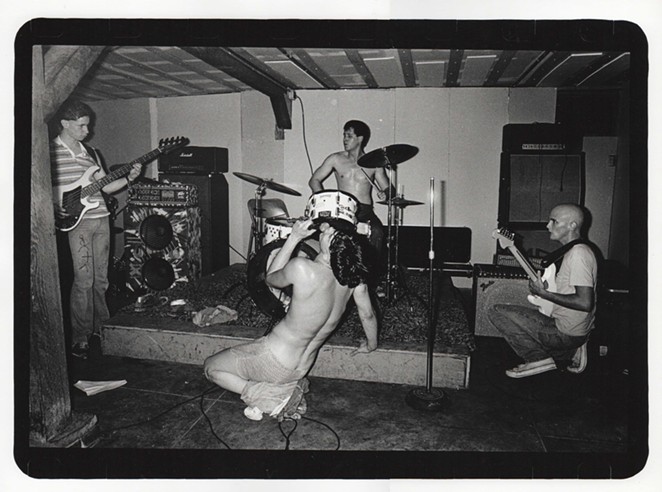
After relocating to Austin and recording the independent albums Locust Abortion Technician, Hairway to Steven and piouhgd, the band made the leap to Capitol Records. John Paul Jones of Led Zeppelin produced the Surfers’ major label debut.
Paul Leary: [Our first place in Austin] was a very funky house plopped down on a weird lot under an abandoned drive-in movie sign. I built a studio in the house and hung pieces of plywood from the ceilings for us to sleep on. Eventually, the highway department condemned the property and we had to move. The highway department gave us $10,000 to move, and we put that money down on a berm house in Driftwood, Texas. It was a great place to decompress after years of touring. It was there that we recorded a jingle for MTV, which was played a lot. It made us the most-played band on MTV at the time, although nobody knew it was us. We recorded the album piouhgd there. The title of that album came from throwing a dirty sock at a computer keyboard.
King Coffey: I think that album title Hairway to Steven was a big reason why John Paul Jones actually worked with us. He liked the cheekiness of the band. [Independent Worm Saloon] was our major label debut, and we put the burden on ourselves to put up or shut up. We made a slick record. We’d never made a record like that before. ... Then we did “Pepper.” I really liked “Pepper” at the time. It reflected what the band were into: trip-hop. The drag is that once it became a hit for us, the label thought we could do it again. And for us, it was a weird experiment. That was hell, to try and follow up a hit in a genre you’ve never really done before. That was a drag.
Changing times, changing expectations
Paul Leary: We loved putting mayhem into our shows. After 9/11, I lost my appetite for mayhem.
Chris Smart: I saw them on their last tour. The single was co-written with Kid Rock, and they were signed to a Disney label. It was generic, not good, and they weren’t into it live. Two hired guns. The backing tracks went out in the middle of their set — the keyboards, the backing vocals — all went out. It’s the kind of thing that the Surfers would have ripped someone apart for doing earlier in their career. But this is not an unfamiliar story. It happens to everyone. You’re young and make these statements, going against the world, and never think ... someday, you’ll have to make a house payment.
Scott Stevens: The last time I saw them was in 2011 at Emo’s here in Austin. It was good hearing the songs again, but the video was not nearly as good as back in the ’80s. Lots of sparkly lights, but none of the weirdness. No penis reconstruction surgery.
Terence Smart: I was disappointed they didn’t create their own alternative mainstream, but they never let themselves get bought out and never conformed enough to get the big, big money. They stayed true to their art.
King Coffey: It’s a really magic time, right now, for music and for culture in general, due to how decentralized everything has become. Not sure how we would have negotiated social media though. With the Butts, we made it deliberate early on to keep as little information as possible, as open ended as possible. There was no picture of what we looked like, no band names on the records. People’s imagination was better than reality! ... Right now, the music scene is better than ever. Bands can put out a record without needing a label to do it. It’s changed the whole dynamics of what a band used to need to put out a record. The rules have changed. Do you even need a record? (Laughs.)
Paul Leary: I don’t pay attention to music in 2021. I listen to music from the ’40s, ’50s, ’60s, ’70s and ’80s. The only music I listen to that is current is whatever I am producing or mixing. What I would tell a kid looking to bust out is to stay in school. I have no idea how young musicians make it in music these days. ... I have family in San Antonio. I return to visit and to get the best Tex-Mex in the world.
Stay on top of San Antonio news and views. Sign up for our Weekly Headlines Newsletter.

